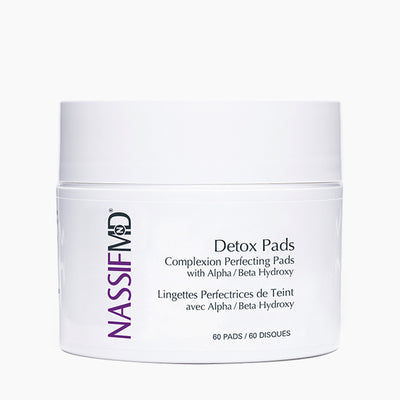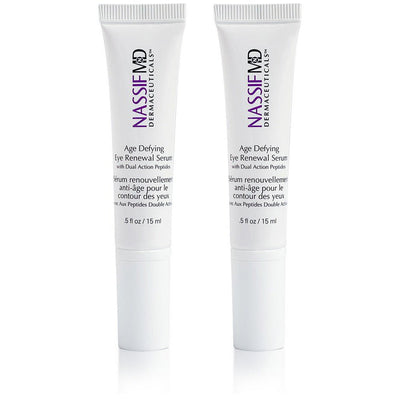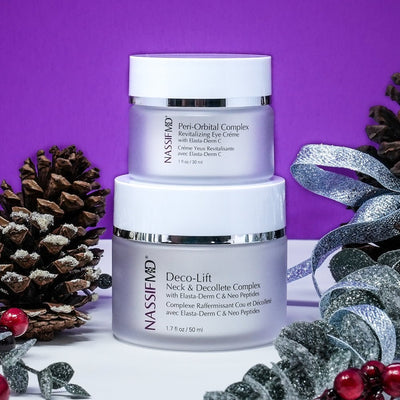Can You Use Salicylic Acid with Retinol?
Salicylic acid and retinol are both active skincare ingredients with anti-aging benefits that promote clear, smooth, and even skin. Separately, each ingredient works differently to grant skin healing benefits, but can you use salicylic acid with retinol?
The short answer is yes, retinol and salicylic acid can be a part of the same skincare routine. With all the skincare dos and don’ts that come with these active ingredients, today’s article will walk through best practices when getting started.
Keep reading as we dive into:
- The BHA exfoliant, salicylic acid
- What is retinol?
- Is it okay to use retinol with exfoliants? Can I use salicylic acid with retinol?
- How to use retinol and salicylic acid safely
- Recommended retinol and salicylic acid products from NassifMD® Skincare
What is Salicylic Acid?
Salicylic acid is an active skincare ingredient originally derived from the bark of the willow tree. It acts as a chemical exfoliant, breaking down bonds that release old, dead skin cells so new, healthy skin cells can shine through. It has antimicrobial properties and is often found in skincare products for oily or acne-prone skin. However, salicylic acid can be used with any skin type, especially if you adjust the frequency of use.
You’ll see this ingredient in:
- Salicylic acid cream
- Salicylic acid toner
- NassifMD® Detox Facial Pads
- NassifMD® Purifying Glycolic Cleanser
- NassifMD® Micro Spa Radiance Resurfacing Peel
BHA Exfoliant
AHA and BHA (alpha and beta hydroxy acids) are categories of naturally hydroxy acids used as topical exfoliants in various skincare products. Salicylic acid is a popular BHA. (Learn more about AHA vs. BHA here.)
Hydroxy acids help remove dirt, oils, dead skin cells, and impurities from the skin’s surface and pores. Exfoliating with hydroxy acids, including salicylic acid, can help:
- Minimize fine lines and wrinkles
- Improve firmness
- Improve hydration
- Remove excess oil
- Allow other skincare ingredients (like retinol) to work better
What is Retinol?
Retinol is another powerful active skincare ingredient. It speeds up cell turnover to reveal the new, younger skin below. Research shows retinol visibly improves the skin’s appearance, reducing wrinkles, fine lines, and hyperpigmentation.
Form of Vitamin A
Retinol is an active form of vitamin A in the category of retinoids. While it’s good to get vitamin A in the diet, topical retinol is one of the most well-known anti-wrinkle agents, making it a popular ingredient in various products such as:
- Retinol cream
- Retinol serum
- NassifMD® Hydro-Screen
- NassifMD® Night Therapy Serum
- NassifMD® Hydro Screen Intense Hydration Face and Body Souffle
- NassifMD® Even Correct & Renew Retexturizing Pads
Stimulate Collagen Production
The use of topical retinol stimulates collagen and elastin proteins. Collagen helps give the skin its fullness and structure, while elastin provides stretch and firmness. More collagen and elastin in the skin means fewer wrinkles, more bounce, and tighter skin.
Can You Use Salicylic Acid with Retinol?
You can use salicylic acid with retinol. It’s important to note that both ingredients are powerful and can be irritating if you’re not used to them. Depending on your skin type, you may not tolerate using both ingredients every day or together and may need to alternate. We’ll discuss some ideas for starting a rotation as you build up your skin’s tolerance shortly.
When you use salicylic acid and retinol together:
- Use salicylic acid first in the exfoliating step of your skincare routine
- Use retinol second, so it penetrates more deeply
- Take steps to keep the skin hydrated
- Wear sunscreen during the day to protect your skin from sun damage, especially as it may be more sensitive from exfoliation and retinol use
Why They Can Be Used Together
You can use salicylic acid and retinol together as your skin tolerates. See the tips below if your skin doesn’t tolerate this or needs to work up to consistent use.
Salicylic Acid Clears Pores for Retinol Penetration
When used in the same routine, salicylic acid and retinol have synergistic effects on skin health and appearance. Salicylic acid clears dead skin and debris from the skin’s surface and pores, allowing other active ingredients in the routine to penetrate more deeply. Deeper penetration makes active ingredients, including retinol, more effective.
Why You Should Proceed with Caution
Even with all the benefits, if you are new to salicylic acid or retinol or using them both together, proceed with caution. Each ingredient can cause irritation, especially for sensitive skin or when first using these ingredients. When used together, the potential for redness and irritation may be even more significant, so starting slowly is important.
Potent Ingredients Can Irritate Skin
When it comes to skincare, using more products and ingredients isn’t always better. There are cases where less is more. Starting out with salicylic acid, retinol, or both is one area where you don’t want to start too aggressively. Too much of either ingredient could lead to irritation, soreness, redness, or skin flaking.
How to Safely Use Salicylic Acid and Retinol in Your Routine
Your skin can build tolerance to salicylic acid and retinol use. The key is to start slowly and expand use as your tolerance grows. Always listen to your skin.
Start Slowly
Start using products containing each ingredient once or twice weekly on different days, ideally leaving about 48 hours between salicylic acid and retinol. If you have overly sensitive skin, this may be all your skin tolerates.
If your skin type allows, begin increasing the frequency of use from there. You may be able to work up to alternating days. From there, you can try using salicylic acid in the morning and retinol at night and even using them together in the same skincare session.
Patch Test First
Patch testing a small area of skin is always a good idea. This way, if your skin does have a reaction, it’s contained.
Monitor Your Skin’s Reaction
Notice how your skin responds to salicylic acid, retinol, or both, and adjust your frequency of use based on your skin’s feedback. Suppose your skin shows signs of irritation, back off. If it’s thriving and you see results, add another weekly application.
Use High-Quality Skincare Products
Unfortunately, not all salicylic acid and retinol products are created equal and may not provide the desired benefits.
NassifMD® facial plastic surgeon skincare offers high-quality, physician-formulated options that contain a synergy of active ingredients to support and nourish the skin while delivering the benefits of salicylic acid and retinol. These ingredients are combined with hyaluronic acid, vitamin C, peptides, niacinamide, and others to address skin wellness from multiple angles.
Let’s explore our favorite products containing salicylic acid and retinol and how to incorporate them into your routine.
NassifMD® Detox Facial Pads are our best-selling complexion-perfecting pads with salicylic acid, glycolic acid, lactic acid, vitamin C, and bakuchiol (a natural retinol alternative. Use the pads after cleansing, starting with 2-3 times weekly.
NassifMD® Hydro-Screen is the best retinol serum with retinol, hyaluronic acid, and ceramides. You don’t need to use hyaluronic acid before or after retinol when you can use them together! You can use this serum after cleansing and exfoliating but before moisturizing. Work up to using it twice daily for anti-aging benefits.
NassifMD® Night Therapy Serum is a retinol serum designed for overnight complexion renewal. It contains advanced retinol, vitamin C, hyaluronic acid, plant antioxidants, and other rejuvenating ingredients. Work up to nightly use after cleansing and toning and follow with a hydrating serum and moisturizer.
NassifMD® Hydro Screen Intense Hydration Face and Body Souffle delivers retinol benefits to the face and whole body with Sytenol A, a gentle retinol alternative, hyaluronic acid, and ceramides. Use this lightweight moisturizing soufflé morning or night (or both) and after NassifMD® Detox Facial Pads.
NassifMD® Even Correct & Renew Retexturizing Pads smooth, even, and brighten the skin with Hy-retin (a non-irritating retinol-hyaluronic acid combination), niacinamide, and mandelic acid. Use twice weekly in the evening after cleansing. Please note that some skin flaking is normal, and daily sunscreen use is recommended.
NassifMD® Purifying Glycolic Cleanser is an exfoliating cleanser with glycolic acid, willow bark extract (the precursor to salicylic acid), and cleansing and nourishing ingredients. Use as a daily cleanser or as tolerated.
NassifMD® Micro Spa Radiance Resurfacing Peel is a two-step resurfacing peel that utilizes salicylic acid, AHA complex, peptides, vitamin C, and antioxidants. It can be used once or twice weekly as an at-home spa treatment.
With so many options, you will surely discover the NassifMD® Skincare that works for you. Salicylic acid and retinol are powerful skincare ingredients that offer immense benefits when used correctly for your skin type. Start slow and see how your skin transforms over time.
References
- Saviuc, C., Ciubucă, B., Dincă, G., Bleotu, C., Drumea, V., Chifiriuc, M. C., Popa, M., Pircalabioru, G. G., Marutescu, L., & Lazăr, V. (2017). Development and Sequential Analysis of a New Multi-Agent, Anti-Acne Formulation Based on Plant-Derived Antimicrobial and Anti-Inflammatory Compounds. International journal of molecular sciences, 18(1), 175.
- Kong, R., Cui, Y., Fisher, G. J., Wang, X., Chen, Y., Schneider, L. M., & Majmudar, G. (2016). A comparative study of the effects of retinol and retinoic acid on histological, molecular, and clinical properties of human skin. Journal of cosmetic dermatology, 15(1), 49–57.
- Zasada, M., & Budzisz, E. (2019). Retinoids: active molecules influencing skin structure formation in cosmetic and dermatological treatments. Postepy dermatologii i alergologii, 36(4), 392–397.



































